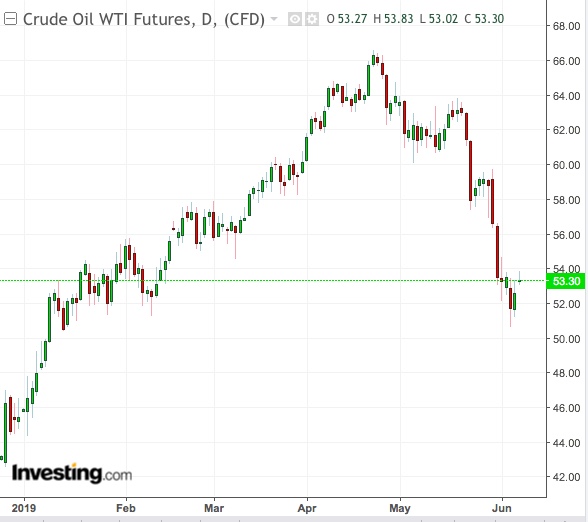Nothing beats the exhilaration of being on the right side of a market. Even better, when the momentum seems totally on your side, prompting you to disregard all caution signs in the way. But regardless of the run you’re having, there’s one sign you should never ignore: the ‘V’ sign. It stands for volatility.
As bears in crude oil hunkered down for another satisfying close Thursday in a market heading for a 5% loss in two days, the tide suddenly turned, and turned forcefully against them. With just about 10 minutes to go, crude futures popped almost 2%. And they continued rising in post-settlement trade with the same vigor. Until then, oil bulls had few places to hide as the market threw everything, from collapsing demand caused by trade wars to abysmal stockpiles data, at them. Instead of retreating, they were now charging back at the bears, as the enemy in recent days—Mexico—appeared to have become a friend. Or had it?
As trading for Friday opened in Asia, oil markets were still climbing, away from the 5-month lows hit before Thursday’s recovery. But the news that sparked the turnaround had become a lot less potent.
The original driver of Thursday’s rebound was a Bloomberg headline that said the U.S. was considering delaying the 5% tariff on Mexican imports due on Monday. But even before the dust had fully settled on Thursday’s trade, it was apparent that traders had read little beyond the headline in dumping their short positions in oil.
The Mexico News That Never Was
The full Bloomberg story, as well as matching versions from the Washington Post to Wall Street Journal, had made clear that President Trump himself had not green-lighted the tariffs delay sought by Mexican officials locked in talks with their U.S. counterparts in Washington. Indeed, shortly after Thursday’s settlement in oil, White House press secretary Sarah Sanders denied in an e-mail that the tariffs on Mexico were being held back, adding that Trump’s position on them had not changed. Sanders’ denial was followed by breaking news that the Trump administration was planning to declare a new national emergency in order to implement sweeping tariffs on Mexico over the flow of Central American migrants to the U.S.
If so, where was the continued driver for Friday’s higher oil prices?

If anything, the events of the past 24 hours have proven that volatility is alive and well in oil, despite the market’s seemingly lower path of resistance over the past three weeks. And things can turn at a whim, particularly when countervailing factors can conjure a more acceptable alternative. From year-to-date gains of more than 40% on April 25, both U.S. West Texas Intermediate and Brent crude have an upside of less than 20% to show now, placing them in bear-market territory.
The selloff since the week of May 12 has been predicated by fears of a likely global recession from the U.S. trade wars with China and Mexico. Adding to the bearish picture was a worsening supply-demand outlook as U.S. oil production hit record highs and crude stockpiles ballooned while gasoline consumption weakened in what should be a seasonably strong period for driving.
Have any of those factors changed since Thursday?
The answer, of course, is no. Not only that, there are interesting statistics to highlight why traders should be worried about the trade wars waged by the Trump administration.
Chief among them is the estimate that says that Mexican tariffs alone could cost the United States 406,000 jobs and more than $41 billion in GDP losses.
That gloomy outlook comes on the back of equally dismal numbers for oil last week that showed crude stockpiles jumped nearly 7 million barrels, versus an expected draw of 850,000. Gasoline inventories surged by 3.21 million barrels last week, compared to expectations for a gain of just 630,000 barrels. Distillate stockpiles rose by 4.57 million barrels, against a forecast for 500,000.
As Many Factors For Oil As Against
Even so, there are as many factors for oil now as against, says Ellen R. Wald, president of Transversal Consulting and an Investing.com contributor.
She cites the continued squeeze on production from OPEC cuts, which could deepen with the cartel’s forthcoming meeting this month; plummeting Iranian and Venezuelan crude shipments owing to U.S. sanctions; disruptions in Libyan oil exports from a civil war; and three-year lows in Russian oil output after pipeline contaminations.
Said Wald:
“By all accounts, these supply issues should have pushed prices higher these past few weeks, but they haven’t.”
“The oil market is currently seeing a major disparity between the fundamentals and the positions of oil traders.”
This means volatility could get worse going forth, any time conviction wavers on either side.
Also not to forget: after a good round of selling, prices will usually rebound on short-covering.
Stephen Innes, managing partner at Vanguard Markets, reminded us of this on Friday:
"After prices hit the depth of the sewer this week, and (were) arguably in oversold territory, traders were always going to be predisposed to book profits ahead of the weekend."
Remember: “V” for Volatility
If that’s not enough, a note from Neuberger Berman back in February tells us of the need to be ever-vigilant of market wings in order to preserve capital and returns.
Said Neuberger Berman in that note:
“When markets stand at inflection points, expect extremes of sentiment and momentum on the upside as well as the downside. After December's sell-off, January's rally has given us the "V" in volatility, but volatile times rarely stop on a dime.”
The investment management firm said that while it remained constructive on risk assets given the forecast for a soft-landing scenario and reasonable valuations, “volatility will likely continue to haunt us as the economy and markets adjust to a more modest growth outlook”.
